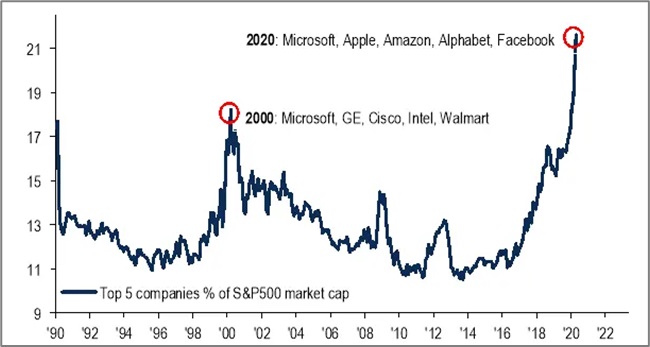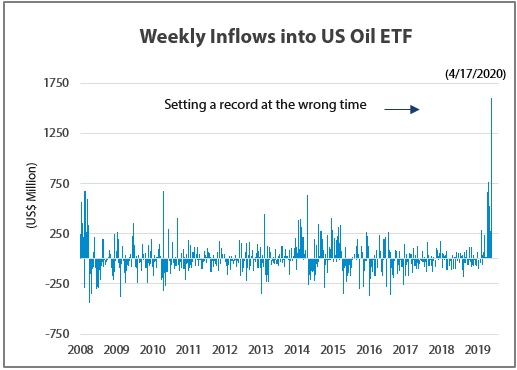Seeking Safety In ETFs? Better Know What You Own
Submitted by Silverlight Asset Management, LLC on April 24th, 2020
“Stay safe” has become a popular saying in The Age of COVID-19.
Things are changing so fast, though, it’s been hard to keep up with all the new rules regarding what qualifies as “safe.”
Example: welcome to Tampa, Tom Brady.
While governments are busy rewriting public safety rules, ETF investors are also rethinking where to find “safety” in the market.
Are Low Volatility ETFs Safe?
Investors seeking safety usually desire low volatility. For them, something like Invesco’s Low Volatility ETF (SPLV) sounds attractive.
However, if these folks were hoping for a tamer ride compared to the normal market roller coaster, they’ve been sorely disappointed. In the toughest stretch of the recent selloff, the ‘Low Volatility’ ETF fell more than the market. SPLV was -35.8% from February 19 through March 23 compared to -33.8% for the S&P 500.
Invesco’s ETF isn’t the only low volatility fund out there, but it holds over $9 billion in assets, which makes it one of the biggest. The strategy is to invest in the 100-most “stable” stocks in the S&P 500 based on realized volatility over the trailing 12 months.
SPLV’s top industry exposures as of 4/22 were: Electric Utilities (25.1%), REITs (15.6%), Insurance (11.7%) and Retail (5.7%).
Therein lies one of the problems. Although utilities have hung in there, REITs have been one of the hardest hit areas. Trailing volatility may not be an optimal way to forecast risk when a major paradigm shift happens. Like when government officials started telling people it’s okay not to pay rent.
Meanwhile, a lot of insurance companies underwrite catastrophe insurance, and could be facing an avalanche of claims.
Obviously, Coronavirus shutdowns have also weighed heavily on many retail businesses. Neiman Marcus, JCPenney, and many others like them, all face possible bankruptcy.
No wonder multi-standard deviation price moves have become uncomfortably common in 2020. Many industries won’t experience a typical V-shaped recovery, or any recovery at all.
In an environment where a high number of firms are facing existential risk, investors may want to think twice before committing capital to ETFs that only allocate based on historical data, like realized volatility.
Future volatility is what counts, and that will largely be determined by future fundamentals.
Are The Biggest ETFs Safe?
SPDR S&P 500 Index Fund (SPY) is one of the most widely owned ETFs, with assets under management totaling over $250 billion. SPY started trading in 1993.
For a long time now, SPY investors have prospered. Yet some market watchers are growing concerned by a new trend under the hood of that ETF as well. Their concerns center around the degree of concentration risk developing at the top of the S&P 500.
Basically, either Big Tech is going to eat the entire market, or there is trouble brewing in the most widely held passive vehicle of all—the S&P 500 index.

Source: Financial Times
The current Fab Five include: Microsoft, Apple, Amazon, Alphabet and Facebook. Since 2016, those five have outperformed at a historic rate.
The last time the S&P was anywhere close to 20% concentrated in the top five names was in 2000, when Microsoft, GE, Cisco, Intel and Wal-Mart were at the top of the heap.
From 2000 - 2010, the S&P’s cumulative return was -9.1%. Pretty uninspiring. Yet it was far better than how the Fab 5 mega-caps fared. All of them lagged, with an average cumulative return of -41.7%.

Will the current crop of mega cap darlings experience a similar fate?
One concern that may point in that direction is valuation. Taking a peek at current valuations versus the five-year average, three of the stocks (Alphabet, Apple and Microsoft) trade two-standard deviations above their 5-year trend. How does that make any sense at all going into a recession?

Source: Bloomberg
Alphabet and Facebook are economically sensitive, believe it or not. In recessions, advertising budgets get slashed. That will show up in earnings.
Amazon isn’t cheap. But it’s cheaper than five years ago and the economic moat just became wider. Amazon’s aggressive reinvestment rate also masks latent earnings power. I’m comfortable being long that one (it’s my top position).
Apple is a pass, for me at least. The company sells high-end products. I’d rather own trade-down consumer names in this climate, like Dollar General and Dominos Pizza. Apple had to close stores and faces supply chain risk. Why pay a premium for that kind of uncertainty?
Are Commodity ETFs Safe?
When retail investors recently piled into the biggest Oil ETF (USO), they were trying to nail a bottom in the toughest part of the market. Instead, they got nailed with an expensive lesson, courtesy of Mr. Market.
It started last week, when a wave of new money poured into USO—an ETF designed to track oil prices. Volume exploded.

Source: Bloomberg
Right after that, oil prices imploded.
On Monday, oil futures turned negative for the first time ever. The May futures contract for WTI crude dropped over $50, settling at minus $37.63.
Forever is a long time, so word got around. News of the oil crash didn’t deter retail investors, though. The jaw-dropping event attracted even more.
Robinhood—a popular retail trading platform—saw over 90,000 investors buy USO in their portfolio, making it the most-added security across the entire platform, according to Robintrack data.
Thing is, USO isn’t really a direct bet on oil.
The ETF derives its price from futures contracts, which are periodically rolled from one month to another.
“There’s a huge cost of carry in the front of the curve,” Benn Eifert told Bloomberg. “The average Robinhood USO buyer and USO call buyer doesn’t know that, doesn’t understand that, or doesn’t care, and thinks they are just buying oil at a low price.”
Whatever they thought—they thought wrong.
USO investors got burned because they didn’t understand what they owned, or what exposures that entailed.
***
When Jack Bogle started the passive investing movement in the 1970s, he had a good idea and the right intentions. He wanted to help the little guy invest more efficiently.
But as we’ve seen with so many things throughout history, good ideas taken too far can become bad ideas.
Are we there yet with the passive investing mania? Mike Green of Logica Capital Advisers has done interesting work on this theme, if you’d like to explore it more.
For now, at least one thing is crystal clear: this is no time for lazy thinking about your investments. So make sure you know what you own.
Originally published by Forbes. Reprinted with permission.
This material is not intended to be relied upon as a forecast, research or investment advice. The opinions expressed are as of the date indicated and may change as subsequent conditions vary. The information and opinions contained in this post are derived from proprietary and nonproprietary sources deemed by Silverlight Asset Management LLC to be reliable, are not necessarily all-inclusive and are not guaranteed as to accuracy. As such, no warranty of accuracy or reliability is given and no responsibility arising in any other way for errors and omissions (including responsibility to any person by reason of negligence) is accepted by Silverlight Asset Management LLC, its officers, employees or agents. This post may contain “forward-looking” information that is not purely historical in nature. Such information may include, among other things, projections and forecasts. There is no guarantee that any of these views will come to pass. Reliance upon information in this post is at the sole discretion of the reader.
Testimonials Content Block
More Than an Investment Manager—A Trusted Guide to Financial Growth
"I’ve had the great pleasure of having Michael as my investment manager for the past several years. In fact, he is way more than that. He is a trusted guide who coaches his clients to look first at life’s bigger picture and then align their financial decisions to support where they want to go. Michael and his firm take a unique and personal coaching approach that has really resonated for me and helped me to reflect upon my core values and aspirations throughout my investment journey.
Michael’s focus on guiding the "why" behind my financial decisions has been invaluable to me in helping to create a meaningful strategy that has supported both my short-term goals and my long-term dreams. He listens deeply, responds thoughtfully, and engages in a way that has made my investment decisions intentional and personally empowering. With Michael, it’s not just about numbers—it’s about crafting a story of financial growth that has truly supports the life I want to live."
-Karen W.
Beyond financial guidance!
"As a long-term client of Silverlight, I’ve experienced not only market-beating returns but also invaluable coaching and support. Their guidance goes beyond finances—helping me grow, make smarter decisions, and build a life I truly love. Silverlight isn’t just about wealth management; they’re invested in helping me secure my success & future legacy!"
-Chris B.
All You Need Know to Win
“You likely can’t run a four-minute mile but Michael’s new book parses all you need know to win the workaday retirement race. Readable, authoritative, and thorough, you’ll want to spend a lot more than four minutes with it.”
-Ken Fisher
Founder, Executive Chairman and Co-CIO, Fisher Investments
New York Times Bestselling Author and Global Columnist.
Packed with Investment Wisdom
“The sooner you embark on The Four-Minute Retirement Plan, the sooner you’ll start heading in the right direction. This fun, practical, and thoughtful book is packed with investment wisdom; investors of all ages should read it now.”
-Joel Greenblatt
Managing Principal, Gotham Asset Management;
New York Times bestselling author, The Little Book That Beats the Market
Great Full Cycle Investing
“In order to preserve and protect your pile of hard-earned capital, you need to be coached by pros like Michael. He has both the experience and performance in The Game to prove it. This is a great Full Cycle Investing #process book!”
-Keith McCullough
Chief Executive Officer, Hedgeye Risk Management
Author, Diary of a Hedge Fund Manager
Clear Guidance...Essential Reading
“The Four-Minute Retirement Plan masterfully distills the wisdom and experience Michael acquired through years of highly successful wealth management into a concise and actionable plan that can be implemented by everyone. With its clear guidance, hands-on approach, and empowering message, this book is essential reading for anyone who wants to take control of their finances and secure a prosperous future.”
-Vincent Deluard
Director of Global Macro Strategy, StoneX

